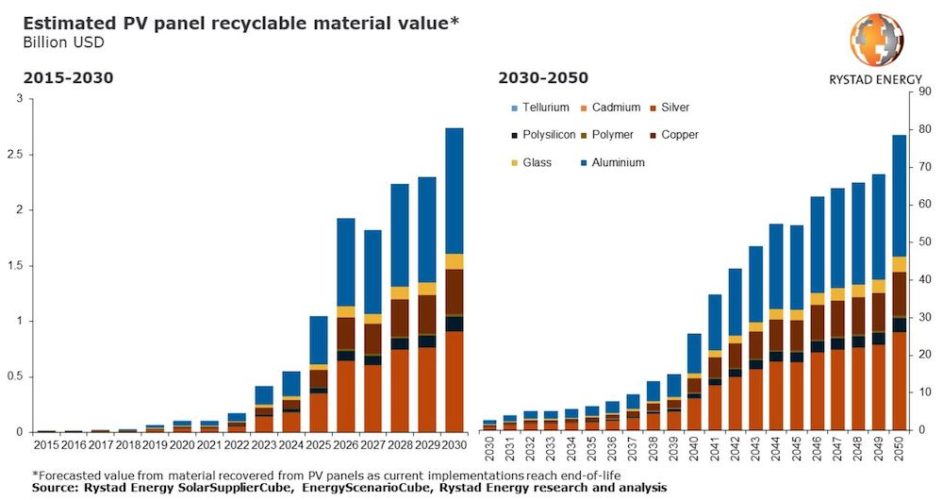Demand for recycled solar photovoltaic (PV) panel components is expected to grow dramatically through the remainder of the decade as installation numbers skyrocket and developers look to avoid supply bottlenecks.
New research published this week by Rystad Energy predicts that recyclable materials from solar PV panels reaching the end of their lifespan will be worth more than $US2.7 billion in 2030 – a mind boggling 1,500% increase over the current value of $US170 million in 2022.
Unsurprisingly, this trend will only accelerate, and is expected to hit $US80 billion by 2050.

In terms of the need for solar PV recycling, current expectations are that solar PV waste will grow to 27 million tonnes each year by 2040.
Conversely, Rystad Energy believes that recovered materials from retired panels could make up 6% of solar PV investments by 2040, as compared to only 0.08% today.
But it is the role in swerving away from an otherwise unavoidable supply bottleneck that is potentially the most important aspect of a solar PV recycling sector. Solar development continues to accelerate, with both residential and large-scale solar farms demanding ever more materials that are in increasing levels of short supply.
Specifically, demand for materials and minerals used in solar PV development will accelerate dramatically, likely causing higher prices, as solar grows to meet around 40% of the world’s power generation in 2050 – equivalent to 19 TW, according to the International Energy Agency’s (IEA) net-zero emissions scenario.
“Rising energy costs, improved recycling technology, and government regulations may pave the way for a market where more defunct solar panels are sent to recycling rather than the nearest landfill,” said Kristin Stuge, Rystad Energy analyst.
“Recycling PV panels can help operators save costs, overcome supply chain woes, and increase the likelihood of countries meeting their solar capacity goals.”
Materials and minerals that can be recycled out of end-of-life solar PV panels include aluminium, silver, copper, and polysilicon, and it is these very materials which are responsible for significant cost and energy values in the overall manufacture of solar panels.
Specifically, while silver accounts for only around 0.05% of the total weight of a solar panel, it nevertheless accounts for up to 14% of the material value. Similarly, polysilicon is obtained through an energy intensive process so as to achieve the concentration needed for solar panel efficiency, and thus yields a relatively high resale price.
Conversely, but just as importantly, glass, which accounts for the greatest volume of material in solar panels, has a high recycling rate but relatively low resale value, once again highlighting the potential value of a solar PV recycling sector.
According to Rystad Energy’s 1.6°C scenario – which, as distinct from the IEA’s net-zero emissions scenario, predicts solar will generate 53% of the world’s power in 2050 – estimates peak solar energy implementation by 2035 of 1.4TW. By this point in time, Rystad predicts that the solar PV recycling industry could supply 8% of the polysilicon, 11% of the aluminium, 2% of the copper, and 21% of the silver needed by recycling solar PV panels installed in 2020.
As for which countries might be best rewarded by a solar PV recycling sector, China, which is expected to account for 40% of global installations in 2022, could see a recycling sector value of $US3.8 billion by 2037, out of a $US9.6 billion global total, based on a 15-year solar PV panel lifespan.
While representative of China’s dominance, another solar PV powerhouse is India, which will nevertheless trail behind with an estimated $US800 million in recycling value, followed by Japan with $US200 million. Regionally, North America is projected to see the value of recyclable material reach $US1.5 billion by 2037, with Europe seeing $US1.4 billion.









